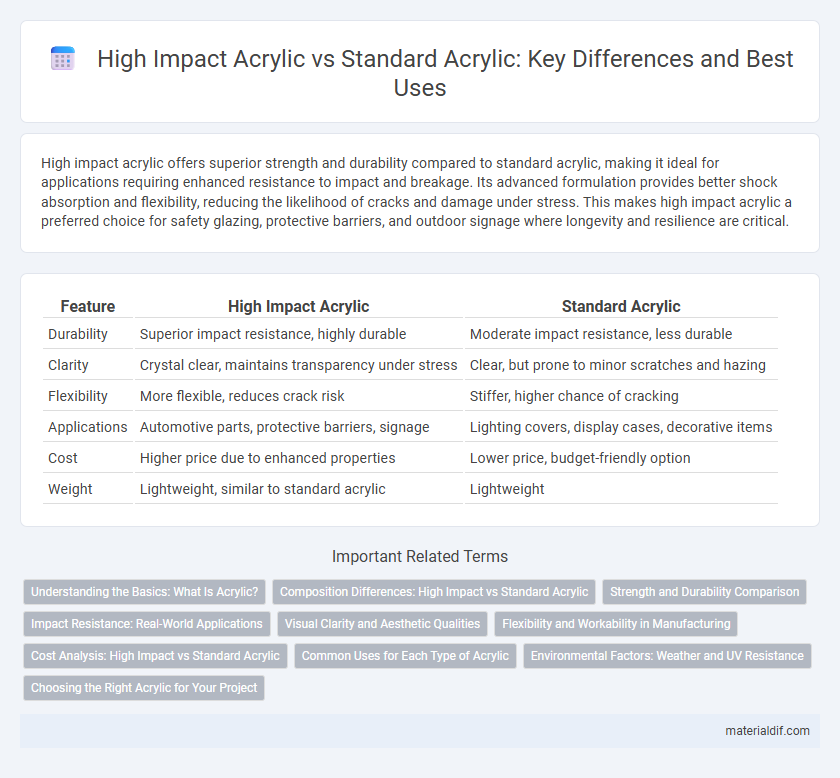High impact acrylic offers superior strength and durability compared to standard acrylic, making it ideal for applications requiring enhanced resistance to impact and breakage. Its advanced formulation provides better shock absorption and flexibility, reducing the likelihood of cracks and damage under stress. This makes high impact acrylic a preferred choice for safety glazing, protective barriers, and outdoor signage where longevity and resilience are critical.
Table of Comparison
| Feature | High Impact Acrylic | Standard Acrylic |
|---|---|---|
| Durability | Superior impact resistance, highly durable | Moderate impact resistance, less durable |
| Clarity | Crystal clear, maintains transparency under stress | Clear, but prone to minor scratches and hazing |
| Flexibility | More flexible, reduces crack risk | Stiffer, higher chance of cracking |
| Applications | Automotive parts, protective barriers, signage | Lighting covers, display cases, decorative items |
| Cost | Higher price due to enhanced properties | Lower price, budget-friendly option |
| Weight | Lightweight, similar to standard acrylic | Lightweight |
Understanding the Basics: What Is Acrylic?
Acrylic is a versatile thermoplastic known for its clarity, durability, and weather resistance, commonly used as a lightweight alternative to glass. High Impact Acrylic contains added modifiers that enhance its toughness and shatter resistance, making it ideal for applications requiring extra durability. Standard Acrylic offers excellent optical clarity and rigidity but is more prone to cracking under impact compared to its high-impact counterpart.
Composition Differences: High Impact vs Standard Acrylic
High impact acrylic contains rubber modifiers integrated into the polymethyl methacrylate (PMMA) matrix, enhancing its toughness and resistance to cracking compared to standard acrylic, which is pure PMMA without additives. The rubber phase in high impact acrylic creates energy-absorbing zones that improve impact strength, making it ideal for demanding applications requiring durability. Standard acrylic offers superior clarity and scratch resistance but lacks the enhanced fracture resistance found in high impact formulations.
Strength and Durability Comparison
High impact acrylic offers superior strength compared to standard acrylic, with enhanced resistance to cracking and shattering under stress. This type of acrylic maintains durability in extreme conditions, making it ideal for applications requiring long-term performance and safety. Standard acrylic, while lightweight and versatile, is more prone to chipping and breaking when subjected to heavy impact or pressure.
Impact Resistance: Real-World Applications
High Impact Acrylic offers significantly greater impact resistance compared to Standard Acrylic, making it ideal for applications requiring enhanced durability such as protective barriers, machine guards, and outdoor signage. Its superior strength reduces the likelihood of cracking or shattering under stress, providing increased safety in environments prone to physical impact. Industries like automotive, construction, and retail benefit from High Impact Acrylic's resilience in demanding real-world conditions.
Visual Clarity and Aesthetic Qualities
High Impact Acrylic offers superior visual clarity with enhanced shatter resistance, making it ideal for applications requiring durability without compromising transparency. Standard Acrylic provides excellent optical clarity but lacks the toughness of high impact variants, which can influence the aesthetic longevity under stress. The choice between the two depends on balancing the need for pristine appearance against the potential for physical impact in the intended use.
Flexibility and Workability in Manufacturing
High Impact Acrylic offers superior flexibility compared to Standard Acrylic, reducing the risk of cracking or breaking during intricate manufacturing processes. Its enhanced workability allows for easier bending, shaping, and machining, making it ideal for complex designs and applications requiring durability. Standard Acrylic, while more rigid, provides a more cost-effective option but may be less suitable for projects demanding high flexibility and precision.
Cost Analysis: High Impact vs Standard Acrylic
High Impact Acrylic typically costs 20-30% more than Standard Acrylic due to its enhanced durability and resistance to cracking under stress. While Standard Acrylic offers affordability for general applications, High Impact Acrylic reduces long-term replacement and maintenance expenses in high-stress environments. Evaluating lifecycle costs reveals that investing in High Impact Acrylic often results in lower total ownership cost despite the higher initial price.
Common Uses for Each Type of Acrylic
High impact acrylic is commonly used in applications requiring enhanced durability, such as automotive lenses, protective barriers, and outdoor signage, due to its superior resistance to impact and weathering. Standard acrylic finds frequent use in indoor displays, picture frames, and decorative panels where clarity and aesthetics are prioritized over extreme toughness. Both types offer excellent optical properties, but selection depends on balancing the need for strength versus lightweight transparency in specific environments.
Environmental Factors: Weather and UV Resistance
High impact acrylic exhibits superior weather resistance compared to standard acrylic, maintaining clarity and structural integrity under prolonged exposure to harsh environmental conditions. Its enhanced UV resistance prevents yellowing and degradation, making it ideal for outdoor applications where long-term durability is essential. Standard acrylic tends to fade and become brittle when subjected to intense sunlight and fluctuating temperatures, limiting its lifespan in exterior settings.
Choosing the Right Acrylic for Your Project
High Impact Acrylic offers superior strength and durability compared to Standard Acrylic, making it ideal for projects requiring enhanced resistance to impact and harsh conditions. Standard Acrylic provides excellent clarity and is more cost-effective, suitable for applications where aesthetics and light transmission are priorities without heavy stress exposure. Evaluating project requirements such as environmental factors, load-bearing needs, and budget constraints ensures selecting the right acrylic type for optimal performance and longevity.
High Impact Acrylic vs Standard Acrylic Infographic

 materialdif.com
materialdif.com